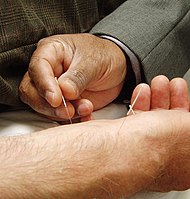
Photo from wikipedia
Primary dysmenorrhea (PDM) is a common complaint in women throughout the menstrual years. Acupuncture has been shown to be effective in dysmenorrhea; however, there are large interindividual differences in patients’… Click to show full abstract
Primary dysmenorrhea (PDM) is a common complaint in women throughout the menstrual years. Acupuncture has been shown to be effective in dysmenorrhea; however, there are large interindividual differences in patients’ responses to acupuncture treatment. Fifty-four patients with PDM were recruited and randomized into real or sham acupuncture treatment groups (over the course of three menstrual cycles). Pain-related functional connectivity (FC) matrices were constructed at baseline and post-treatment period. The different neural mechanisms altered by real and sham acupuncture were detected with multivariate analysis of variance. Multivariate pattern analysis (MVPA) based on a machine learning approach was used to explore whether the different FC patterns predicted the acupuncture treatment response in the PDM patients. The results showed that real but not sham acupuncture significantly relieved pain severity in PDM patients. Real and sham acupuncture displayed differences in FC alterations between the descending pain modulatory system (DPMS) and sensorimotor network (SMN), the salience network (SN) and SMN, and the SN and default mode network (DMN). Furthermore, MVPA found that these FC patterns at baseline could predict the acupuncture treatment response in PDM patients. The present study verified differentially altered brain mechanisms underlying real and sham acupuncture in PDM patients and supported the use of neuroimaging biomarkers for individual-based precise acupuncture treatment in patients with PDM.
Journal Title: Frontiers in Neuroscience
Year Published: 2020
Link to full text (if available)
Share on Social Media: Sign Up to like & get
recommendations!